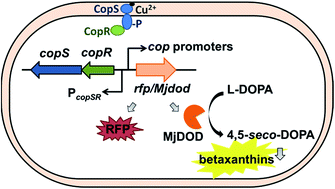Development of a pigment-based whole-cell biosensor for the analysis of environmental copper†
Abstract
Using engineered microorganisms to detect heavy metals in the environment has proven to be highly effective and robust. This paper reports on the development of a novel microbial sensor for the detection of copper ions. To develop this microbial sensor, we screened and characterized various biological parts, including promoters, output signals, and hosts. In addition, we used the plant pigment betaxanthin to output fluorescent signals in order to reduce the detection time. The resulting whole-cell biosensor presented a good sensitivity when detecting copper ions in environmental samples including freshwater pond and tap water.



 Please wait while we load your content...
Please wait while we load your content...